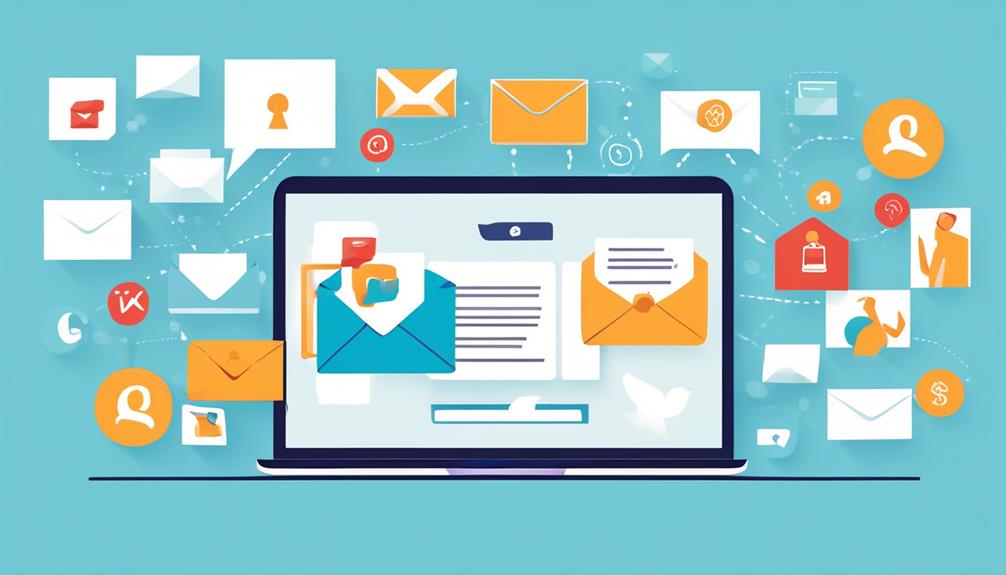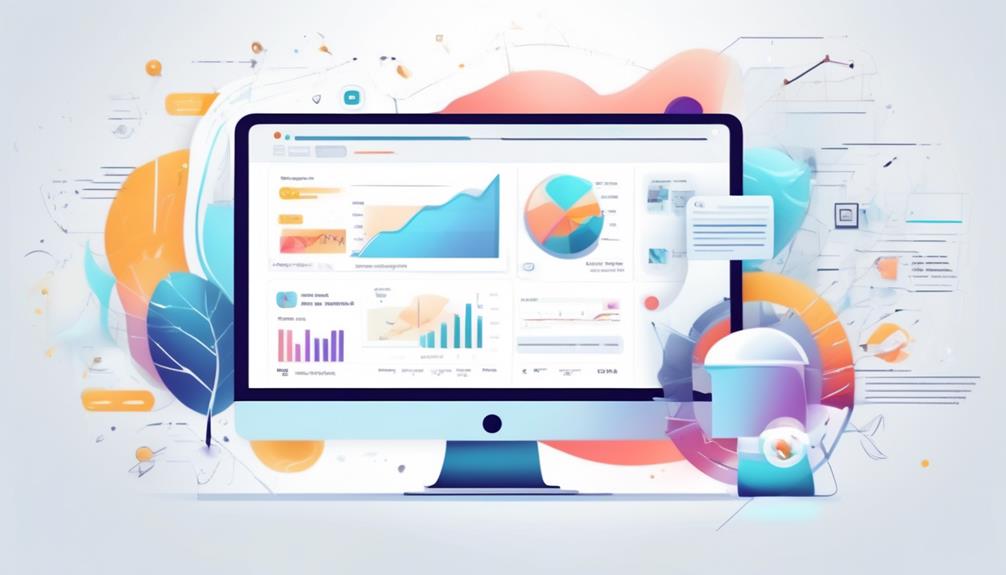Have you heard the rumors that email marketing is on the verge of becoming obsolete? Given the rise of social media and other digital marketing channels, it’s easy to see why some may think that email is losing its importance.
However, before we jump to conclusions, let's take a closer look at the data and trends shaping the future of email marketing. There's more to this story than meets the eye, and the evidence might just surprise you.
Key Takeaways
- Email marketing remains a crucial channel for reaching targeted customers.
- Email marketing has 66% more conversions than any other channel.
- Personalization and engaging content drive higher open and click-through rates.
- Email marketing continues to adapt and thrive, making it a crucial component of any comprehensive digital marketing strategy.
The Evolution of Email Marketing
The Evolution of Email Marketing has been shaped by the rapid advancements in technology and the changing behavior of consumers, making it imperative for marketers to adapt their strategies accordingly.
Email marketing, despite its age, continues to thrive as a crucial channel for reaching targeted customers. With over 5.5 billion email accounts worldwide and 92% of online adults using email, its effectiveness for acquiring new customers surpasses that of Facebook or Twitter by over 40 times. Moreover, it boasts 66% more conversions than any other channel, emphasizing its importance in the marketing mix.
The evolution of email marketing has adapted to changes in technology and user behavior. Personalization has become a key priority, and integrating it with other digital marketing strategies has become essential for overall campaign effectiveness. As we look to the future, AI and machine learning advancements offer potential for hyper-personalized content and automation. Thus, it's crucial for email marketers to stay abreast of technological advancements and continuously adapt their strategies to remain competitive.
Despite challenges such as spam filters and GDPR compliance, email marketing continues to be relevant and important, providing a high return on investment (ROI), direct communication with the audience, and the ability to build trust and loyalty. Therefore, understanding the evolution of email marketing is vital for marketers to capitalize on its continued effectiveness.
Common Misconceptions

Frequently overlooked, misconceptions about email marketing can hinder businesses' success and impact their ability to effectively engage with their audience. Despite the misconception that email marketing is dead, it remains a powerful tool for businesses. Ignoring this valuable channel can result in missed opportunities to reach and engage with potential and existing customers.
Personalization and engaging content are key factors in driving higher open and click-through rates. Contrary to another misconception, ignoring GDPR standards can lead to legal consequences, potentially damaging a business's reputation and trust with subscribers. Additionally, mobile-friendly templates are crucial, as the majority of users access emails on mobile devices. Neglecting this aspect can lead to high bounce rates and reduced engagement.
Outdated email marketing practices, such as impersonal address lines and disregarding user experience, can significantly impact campaign success. Understanding and dispelling these misconceptions is essential for businesses to leverage the full potential of email marketing and achieve their marketing goals.
Current Challenges
Crafting engaging content and avoiding spam filters are crucial challenges in email marketing, requiring continuous learning and adaptation to keep campaigns effective.
In today's digital landscape, marketers face the ongoing challenge of creating content that resonates with their audience while navigating increasingly stringent spam filters. The implementation of GDPR prompted a shift in marketing strategies, emphasizing the importance of obtaining consent and building more targeted and engaged audiences.
Personalization has emerged as a potent tool in email marketing, fostering higher engagement and conversion rates. Integrating email with other digital marketing strategies amplifies the overall effectiveness of campaigns, creating a cohesive and impactful brand presence.
Embracing technological advancements, such as AI, is essential for staying ahead in the email marketing realm. As the landscape continues to evolve, staying abreast of current trends, regulations, and best practices is paramount for success in email marketing.
Strengths and Advantages

Utilizing email marketing offers a direct and impactful means of engaging with our audience, fostering trust and loyalty while delivering impressive click-through rates and a high return on investment.
With an average open rate of 20.81% across all industries, email marketing allows for direct communication with our audience. This fosters a sense of trust and reliability, as consumers look forward to receiving marketing emails, with 61% welcoming them at least once a week.
Moreover, email campaigns have 6 times higher click-through rates compared to tweets, highlighting their effectiveness in engaging audiences. This indicates that our audience isn't only accepting but also engaging with the content we deliver through email.
Additionally, email marketing delivers a high ROI, with a $44 return for every dollar spent, showcasing its cost-effectiveness and efficiency. The consistency in quality results compared to other marketing channels underlines its reliability and potential for success.
These strengths and advantages position email marketing as a powerful tool for directly engaging our audience, fostering trust and loyalty, and delivering significant returns on our marketing investment.
Integration With Other Strategies

By integrating email with other digital marketing strategies, we can amplify the overall effectiveness of our campaigns and maximize engagement with our audience. This integration allows us to create a cohesive and immersive brand experience across different channels, reinforcing our messaging and increasing the likelihood of conversion.
Here are three key ways in which integrating email with other digital marketing strategies can significantly benefit our campaigns:
- Boosting Engagement: Utilizing email to follow up on a social media campaign can significantly boost engagement and reinforce the messaging conveyed through social platforms.
- Informed Content Enhancement: Insights from social media management tools and website analytics can inform and enhance email content, ensuring that our messages are tailored to the preferences and behaviors of our audience.
- Refined Optimization: Cross-channel data utilization enables us to refine and optimize our email strategies for better performance, leveraging the strengths of each channel to maximize the impact of our campaigns.
Impact of Social Media

Social media's influence on consumer behavior is undeniable. 54% of social browsers use platforms to research products. This shift in behavior also impacts email engagement trends. Consumers now expect personalized, relevant content across all channels, including email. Therefore, understanding the impact of social media on consumer behavior is crucial. It is essential for adapting email marketing strategies to meet evolving consumer expectations and maximize campaign effectiveness.
Social Media's Influence
With over 5.5 billion email accounts in use worldwide and a majority of email users spending significant time browsing marketing emails each week, the influence of social media on email marketing can't be underestimated.
Social media has a massive impact, as it complements email marketing efforts by providing opportunities for cross-promotion and engagement with a wider audience.
Email marketing remains highly effective, delivering a high ROI and driving more conversions than any other channel, including social media.
Integrating email with other digital marketing strategies, including social media, amplifies overall campaign effectiveness and allows for a more cohesive and personalized customer experience.
As such, social media's influence on email marketing isn't about overshadowing its effectiveness but rather enhancing and complementing its impact.
Changing Consumer Behavior
Changing consumer behavior due to the impact of social media has significantly influenced the effectiveness and relevance of email marketing in today's digital landscape. As seen in the table below, over 5.5 billion email accounts are in use worldwide, indicating the continued importance of email in communication. Integrating email with other digital marketing strategies amplifies overall campaign effectiveness, demonstrating the adaptability of email marketing in response to changing consumer behavior. Despite the rise of social media, email consistently delivers quality results compared to other marketing channels. The future of email marketing involves embracing technological advancements such as AI and machine learning for hyper-personalized content. Thus, marketing emails remain an effective tool for nurturing relationships with prospects and customers, allowing for personalized and targeted communication.
| Facts | Impact |
|---|---|
| Over 5.5 billion email accounts in use worldwide | Email remains a vital communication tool |
| Integrating email with other digital marketing strategies | Amplifies overall campaign effectiveness |
| Email consistently delivers quality results | Compared to other marketing channels |
Email Engagement Trends
Email engagement trends reflect the evolving impact of social media on digital communication strategies.
1) Social media integration: Marketers are leveraging social media to enhance email engagement, using platforms like Facebook, Instagram, and Twitter to promote email content and drive traffic.
2) Interactive content: Engaging email content, such as polls, quizzes, and user-generated content, is gaining popularity, creating a two-way communication channel and increasing email open rates.
3) Omnichannel approach: Email marketing is being integrated with social media, mobile apps, and other digital channels, providing a cohesive customer experience and boosting overall engagement.
As social media continues to shape consumer behavior, email marketers must adapt by embracing these trends to maximize engagement and ROI.
Email Vs. Other Channels

Email marketing has proven its effectiveness time and time again, especially when compared to other channels. The data speaks for itself – with higher acquisition success, ROI, and conversion rates, email stands out as a powerful marketing tool.
As we consider the future of email, it's clear that advancements in AI and machine learning will only enhance its potential for delivering hyper-personalized content and maintaining its effectiveness in the evolving digital landscape.
Email Effectiveness Compared
With over 5.5 billion global accounts and a demonstrated 81% acquisition success rate, email marketing outperforms other channels in reaching and acquiring new customers. When comparing email effectiveness to other marketing channels, consider the following:
- Wider Reach: Email has a wider reach with over 5.5 billion accounts globally, compared to social media profiles.
- Higher Acquisition Success: 81% of retail professionals consider email marketing effective for acquiring new customers, showcasing its effectiveness.
- Engagement Rates: Email campaigns have six times higher click-through rates compared to tweets, demonstrating their ability to engage audiences effectively.
These facts highlight the unmatched effectiveness of email marketing in customer acquisition and engagement, making it a crucial component of any marketing strategy.
As the debate on 'Email Marketing Dead' continues, the data clearly supports the enduring power of email automation in today's digital landscape.
Other Channel Performance
In today's digital landscape, the performance of email marketing stands out when compared to other channels, with its higher delivery rate, acquisition effectiveness, and engagement potential.
Email marketing boasts a delivery rate of 90% to the intended inbox, far surpassing the mere 2% of a company's Facebook followers who see their posts.
Retail professionals consider email marketing 40 times more effective for acquiring new customers than Facebook or Twitter. Additionally, it drives 6 times higher click-through rates compared to tweets, making it an effective channel for engagement.
With a high ROI of $44 for every dollar spent and its ability to generate the most ROI for over half of marketers' companies, email marketing continues to showcase superior performance compared to other marketing channels.
Integrating email with other digital marketing strategies further amplifies overall campaign effectiveness.
Future of Email
Amidst the evolving landscape of digital marketing channels, the future of email marketing presents a compelling case for its enduring relevance and strategic significance.
1) Email marketing continues to thrive with high ROI figures and engagement rates, making it an essential channel.
2) Integrating email with other digital marketing strategies amplifies overall campaign effectiveness and boosts engagement.
3) AI and machine learning advancements offer potential for hyper-personalized content, emphasizing the need to stay abreast of technological advancements.
As technology advances, email marketing is still the most preferred marketing channel for consumers, delivering the highest ROI of all marketing channels. It's evident that email marketing is far from dying; instead, it continues to adapt and thrive, making it a crucial component of any comprehensive digital marketing strategy.
The Future Outlook

Embracing technological advancements such as AI and machine learning will be pivotal in shaping the future of email marketing, enabling hyper-personalized content and automation for enhanced engagement and ROI. As we look ahead, it's evident that email marketing will continue to evolve and remain a cornerstone of successful marketing strategies. The table below illustrates the enduring effectiveness of email marketing and its high ROI compared to other channels.
| Aspect | Email Marketing |
|---|---|
| Acquisition of Customers | Highly effective in acquiring new customers and driving conversions |
| Return on Investment | High ROI compared to other marketing channels, showcasing its financial benefits |
| Personalization | Integration of AI and machine learning for hyper-personalized content |
The future outlook for email marketing is promising, especially when considering its direct communication with the audience, ability to build trust and loyalty, and its integration with other digital marketing strategies to boost overall campaign effectiveness. Therefore, it's clear that email marketing is not dying; on the contrary, it continues to thrive and adapt, ensuring its relevance in the ever-changing landscape of digital marketing.
Effective Practices

Utilizing advanced targeting techniques and personalized content, effective email marketing practices consistently drive high engagement and conversions, making it a pivotal component of successful marketing strategies.
To ensure the most effective email marketing practices, we recommend the following:
- Leverage Email Marketing Tools: Embrace sophisticated email marketing tools such as Campaign Monitor to optimize your campaigns, personalize content, and automate processes, ensuring that your emails are delivered at the right time to the right audience.
- Prioritize Personalization: Tailoring content to individual preferences and behaviors increases engagement and conversions. Personalized subject lines and product recommendations can significantly enhance the impact of your emails.
- Integrate with Other Marketing Strategies: Email marketing shouldn't exist in a silo. Integrating it with other digital marketing efforts such as social media, content marketing, and customer relationship management (CRM) can amplify its effectiveness and impact.
Key Metrics and Analytics
Analyzing key metrics and analytics is essential for evaluating the effectiveness of email marketing campaigns and optimizing their impact on engagement and conversions. To truly gauge the success of our efforts, we must delve into the data provided by key metrics such as open rate, click-through rate (CTR), conversion rate, bounce rate, and subscriber growth rate. These metrics offer valuable insights into the performance of our email marketing campaigns, enabling us to make informed decisions and drive strategic improvements.
| Key Metrics | Description |
|---|---|
| Open Rate | Percentage of recipients who opened the email, indicating initial engagement with the content. |
| Click-Through Rate | Percentage of recipients who clicked on a link within the email, showing interest in the content. |
| Conversion Rate | Percentage of recipients who completed a desired action, providing insight into the effectiveness of the email. |
| Bounce Rate | Percentage of emails that were not delivered successfully, indicating potential issues with the email list. |
| Subscriber Growth Rate | Rate at which your email list is growing, reflecting the success of your email marketing efforts. |
Engaging Your Audience

We need to focus on engaging our audience through strategic content creation and interactive campaigns.
By providing ongoing value and personalizing our emails, we can ensure that our audience remains interested and engaged.
It's also crucial to collect and respect audience preferences while prioritizing mobile optimization to enhance their experience.
Audience Engagement Strategies
To effectively engage your audience, focus on providing ongoing value to customers to keep them connected with your brand. Here are three key audience engagement strategies for email marketing:
- Prioritize Personalization: Tailor content and use triggered nurturing to create a more personalized experience for your audience. Personalization enhances relevance and resonates with your subscribers, leading to higher engagement and conversions.
- Measure and Optimize Performance: Use key performance indicators (KPIs) such as conversions and click-through rates to measure and optimize email performance. Data-driven insights enable continuous improvement and refinement of your email marketing strategies.
- Integrate with Other Strategies: Integrate email with other digital marketing strategies to amplify overall campaign effectiveness and engagement. A cohesive approach across channels reinforces brand messaging and enhances the customer experience.
Embracing these strategies will drive meaningful engagement and results in your email marketing campaigns.
Personalized Content Creation
Leveraging personalized content creation in email marketing significantly enhances audience engagement and drives better results. By tailoring content to specific audience segments, we can build stronger relationships and increase conversion rates. Personalization enhances the relevance and value of email content, leading to higher open and click-through rates. Understanding audience needs and interests is crucial for creating resonant personalized content. It's a key strategy for maximizing the effectiveness of email marketing campaigns.
| Benefits of Personalized Content Creation |
|---|
| Builds stronger relationships |
| Increases conversion rates |
| Enhances relevance and value |
| Drives higher open and click-through rates |
| Maximizes the effectiveness of email marketing campaigns |
Personalized content creation is not only a strategy but a necessity in today's email marketing landscape. It's the gateway to capturing audience attention and achieving better results.
Interactive Email Campaigns
Enhancing email engagement through interactive campaigns is a strategic method to captivate audiences and gather valuable feedback.
Interactive email campaigns allow for increased engagement by incorporating elements such as quizzes, surveys, and polls directly within the email. By utilizing interactive email campaigns, you can encourage audience participation and gather valuable feedback or data through embedded forms and interactive elements.
Incorporating interactive elements like image carousels, accordions, or videos within your email campaigns can captivate your audience and provide a more immersive experience.
Leveraging interactive email campaigns can help you stand out in crowded inboxes, as they offer a unique and engaging way to communicate with your audience.
This data-driven approach to email marketing ensures that your campaigns aren't only seen but also actively interacted with, leading to higher conversion rates.
Does the Length of Marketing Emails Impact Their Effectiveness in the Age of Email Marketing Decline?
In the age of email marketing decline, the ideal length for marketing emails is a critical consideration. Shorter, concise emails tend to perform better, with a higher open and click-through rate. However, it ultimately depends on the audience and the content. Testing different lengths is key to finding the right balance.
Frequently Asked Questions
Is Email Marketing on the Decline?
Email marketing isn't on the decline. Our data-driven analysis shows that it remains a vital tool in reaching and engaging targeted customers. With a wide reach and high return on investment, it consistently outperforms other channels.
Evolving to meet technological changes and user behavior, it has adapted to remain effective and cost-efficient. Despite challenges, it continues to build trust, loyalty, and drive higher engagement and conversion rates.
Is Email Marketing Still Effective 2023?
Absolutely, email marketing remains a highly effective strategy in 2023. With a proven track record of driving conversions and delivering a high ROI, it continues to be a valuable channel for acquiring new customers.
The accessibility, reliability, and potential for hyper-personalized content through AI advancements solidify its relevance.
Integrating it with other digital marketing strategies amplifies overall campaign effectiveness, making it a crucial component of a comprehensive marketing approach.
Is There a Future for Email Marketing?
Absolutely, there's a future for email marketing. It remains a vital tool for customer acquisition and engagement, with high ROI and widespread user adoption.
Our team believes in leveraging advanced AI and personalization to adapt to changing consumer preferences, ensuring ongoing value for customers.
The strategic use of email marketing, supported by data-driven insights, will continue to drive success for businesses and marketers in the ever-evolving digital landscape.
Is Email Being Phased Out?
Email isn't being phased out. It remains a crucial part of our marketing strategy. With over 5.5 billion email accounts in use worldwide and a $44 return for every dollar spent, email marketing delivers exceptional results. We consistently see higher click-through rates and more conversions compared to other channels.
Integrating email with other digital strategies amplifies our overall campaign effectiveness. The future of email marketing lies in AI advancements, offering potential for hyper-personalized content.
Conclusion
In conclusion, email marketing is definitely on its last legs, just like how social media was supposed to replace it. With its high ROI, engagement rates, and effectiveness in acquiring new customers, it’s clear that email marketing is on life support. Some may argue that email marketing is still effective, citing the potential for personalized and targeted messaging. However, the reality is that consumer behavior and preferences have shifted towards other channels such as social media and messaging apps. Therefore, the question remains: is email marketing still effective in reaching and engaging with today’s consumers?
So, let's just ignore the 5.5 billion email accounts and the higher click-through rates, because who needs all that when we can just rely on the next big thing that's totally going to replace email, right?










